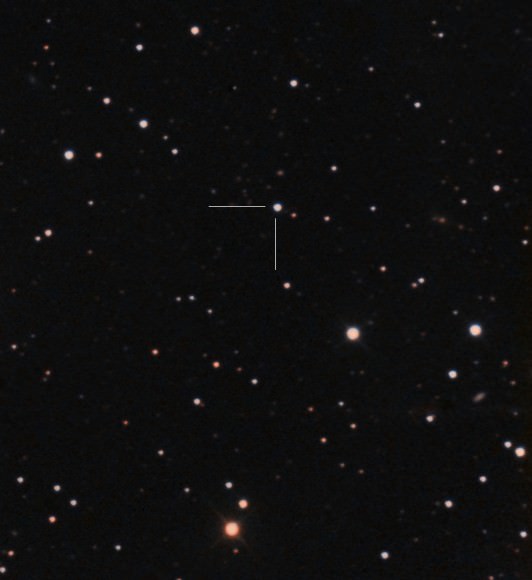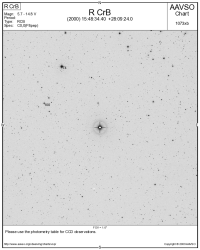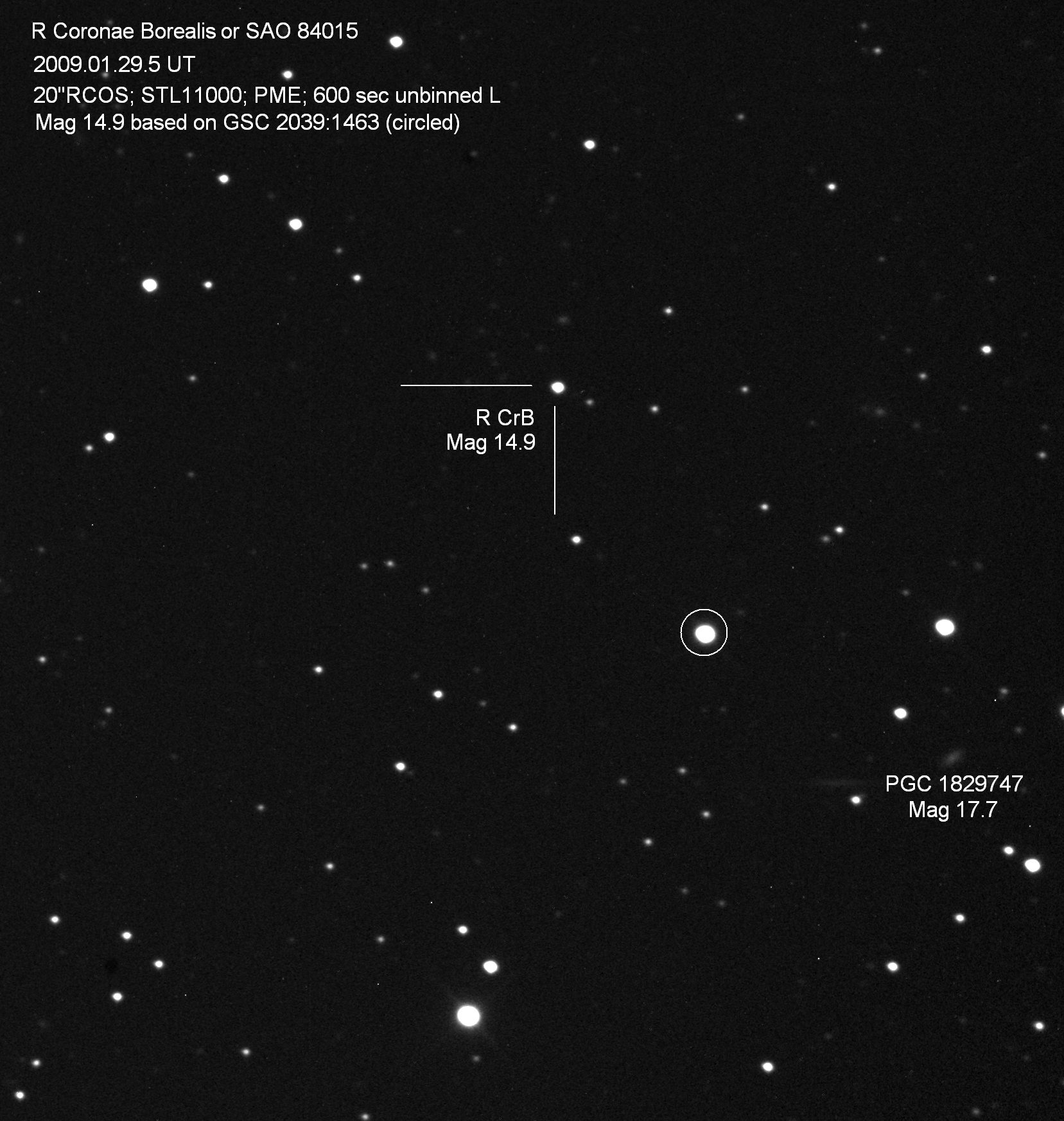[/caption]
For those of you who like observing curiosities, it’s time to take a look at R Coronae Borealis. As you may have guessed from the single letter designation, R is a variable star, but it’s not just any old variable – it’s the prototype of its class. What exactly is an R CorBor star, what does it do and why is taking the time to check it out now so important? Then step inside and find out…
R Coronae Borealis stars (RCB) type stars are one of the oldest known classes of variable star. In just a period of a few weeks, they can drop in brightness by factors of thousands and what they do is totally unpredictable. Within months, they recover again to their maximum brightness… But why? While astronomers don’t fully understand the evolutionary origin and the physical mechanism behind what drives R CorBor types, they do know the stars pulsate – generating a sort of sooty dust cloud just above the surface. Like an old-fashioned oil lamp with its wick turned up too high, when R Cororonae Borealis stars burn their fuel, they smoke up their exterior – just like the lamp smokes its glass chimney and dims the light. What remains on the glass? That’s right. Carbon. And the surfaces of RCB stars are unusually poor in hydrogen, and rich in carbon and nitrogen. Chances are very good that R CorBor stars are actually the remnants of more fully evolved stars.
Just a few days ago, M. Templeton of the American Association of Variable Star Observers (AAVSO) released Special Notice #145:
“R Coronae Borealis, the prototype of the R CrB class, is apparently at or near historic minimum; a number of observers have put this star below m(vis)=14.0 since early November 2008, and both visual and instrumental measures are now indicating R CrB is near or below V=14.5. R CrB began its current fading episode around JD 2454288 (2007 July 6 +/- 1 day), and faded from m(vis) ~ 6.0 to below m(vis) ~ 12.0 by JD 2454325 (2007 August 12). The star has continued to fade for the past 17 months. Current visual observations by a number of AAVSO visual observers estimate the star to be around m(vis) 14.3-14.5, and V-band CCD observations suggest the star may be at or near V=15.0. BAAVSS observer J. Toone also visually estimated the star is at m(vis) ~ 14.9 (via baavss-alert). Both visual estimates and instrumental photometry of R CrB are strongly encouraged at this time.
The duration of the current episode and its depth are similar to that observed during the previous extreme fading episode which began circa JD 2438200 (June 1963) and continued with only one brief interruption until circa JD 2439100 (December 1965). During the 1963-1965 event, a few AAVSO observers estimated that R CrB reached m(vis) around 14.9-15.0, although the average visual estimate remained around 14.2-14.3 at minimum. The current episode seems to have reached the same depth; there is no way to tell whether the fade will continue, although the light curve has been flat or trending weakly downward for several months. As J. Toone pointed out, the current magnitude is very close to if not fainter than the historic minimum for this star.”
Of course, nearing magnitude 15 isn’t within the territory of binoculars or small telescopes – but it is within the grasp of many of our amateur astronomer UT readers with larger equipment, clear skies and the willingness to seize the opportunity to record this historic astronomical event. (I dislike the term “amateur” – it only means you don’t get paid for it, folks… Not that you’re any less serious or talented!) One such astronomer is Dr. Joseph Brimacombe, who took up the gauntlet immediately. Although Joe hails from Australia where R Coronae Borealis isn’t visible, today’s astronomy world is far different than it used to be. Thanks to the magic of the Internet, he immediately set about the task of capturing the star on January 30, 2009 via a robotic telescope located in New Mexico and shared his results with us.


My many thanks to Joe Brimacombe of Northern Galactic for his superb talents and to the AAVSO for keeping us on alert!


Clouds… all I can see is layers and layers of clouds…
These anti-novae, because the light-curve is a mirror image of novae (which brighten dramatically) are certainly exciting types of variables, being fairly rare beasties.
Minor corrections : As for “Although Joe hails from Australia where R Coronae Borealis isn’t visible,” isn’t quite true.
If the position at RA: 15 48 34.40 , Dec: +28 09 24.0 indicates this star is observable at least for sometime of the year from latitudes north of -61 deg 51’S latitude – covering all of Australia and Tasmania. Corona Borealis culminates on 16th May at midnight, and from much of mainland Australia, with R CrB easily visible for eight hours of darkness, and is best observed from March to August each year..
Southern observers regularly observe this star too, I I think even the Australian variable star observer, Peter Williams of the Sutherland Astronomical Society in southern Sydney has been first to catch the start of the fall in brightness several years ago. I myself have viewed this star from Sydney many times myself.
Also..
1) The best southern examples of these kinds of stars are probably; S Apodis, RY Sagittarii and V Corona Australis.
2) For many years, the total number of known R CrB variables has been a meagre twenty six (26).
3) The only thing Australians usually hail is a taxi.
It should be noted that the decrease in visual magnitude is matched by a corresponding increase in the infrared as light is redshifted by the dust. The total bolometric magnitude (output) is constant, indicating a surface effect, not something going on in the core. pete
hi, pete! thanks for reinforcing that the dimming is a surface effect. just like with the oil lamp… it doesn’t happen to the flame – only the chimney outside.
AJ? heheheee…. ok! smack my hands! r corbor is visible from australia – but not exactly what you’d call in a photographically prime position at the moment. joe is a wonderful friend and research partner and if there’s anything in the world i admire, it’s that aussie determination to do or die trying. we both delight in our cultural differences (and similarities) and in ohio?
hail means there’s a tornado on the way.
😉
smile and be delighted in your countrymen’s success! you guys are some of the hardest working astronomers i know and love…